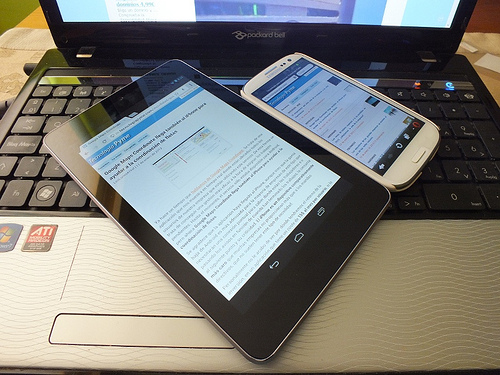Those living the ‘freelance dream’ are mostly pretty preoccupied with the source of their next paycheck. To keep the cash flowing, though, freelancers need to make sure they’ve got the best tools for the job. In this article, we’ll run through a few pieces of modern technology that will help you spend less time working and more time chasing new clients.
Tablet, laptop, desktop, or smartphone … or all of the above?
Tempting though it may be to pick up the latest and greatest – after all, your company is not exactly going to provide you with a computer – freelancers need to exercise due caution when it comes to selecting the right bits of hardware. Limited budgets, frequently shifting financial circumstances and constantly changing client demands require that we pick the best, and only the best, tools for the job. Given the change in client requirements between different jobs, it might be wise to consider a leasing program of some sort, which will allow you to swap in and swap out hardware to keep yourself constantly poised.

In terms of hardware acquisition, it makes sense to start with the most useful tool first. Even given the world’s current tablet and smartphone frenzy, a laptop is still by far and away the most useful tool any mobile worker can have. If you know you’re going to be sitting at a desk, consider a desktop computer, but even if you feel there’s only a slight chance you might want to go mobile once in a while, a laptop makes more sense for the majority of freelance personnel.
There are whole websites devoted to helping you find the best computer, and it depends on your particular needs and desires. However, it is important for you to pick a laptop that meshes neatly with whatever kind of hardware you’re using in other categories: especially your smartphone.
Smartphones pour from shop windows like expensive glassy waterfalls of productivity: you’re not exactly limited for choice, right now. The big guns, of course, are Apple’s iPhone and Samsung’s Galaxy, but don’t neglect other newcomers, such as the Nokia Lumia 920 (which runs Windows Phone 8) and the BlackBerry Z10 (which runs BlackBerry’s latest BB OS 10). Inter-device connectivity is the key point here: if your laptop is a Mac, you’ll probably want to opt for an iPhone. If you’ve picked up a Windows 8 ultrabook or laptop, take a look at a Windows 8 phone. All of this makes sense – the kinds of activities that freelancers spend most of their time doing can really benefit from a coherent access and storage system. Browsing the web, authoring documents, sorting out invoices and proposals – whichever ecosystem you want will have its own angle on these activities, so make sure you’re approaching them the same way from all your platforms.
Tablets, once the reserve of elitist technology fanboys, have enjoyed quite a staggering renaissance (in no part down to the suggestive ‘post-PC’ title many of them seem to have acquired from somewhere). While few professionals would ever seriously recommend ditching your laptop for a tablet, there are times and workflows that benefit from a light, touch-friendly approach. For example, freelancers with heavy involvement in fieldwork might find a tablet – such as the Microsoft Surface or Apple iPad – offers something a laptop cannot. Lightness, extended battery life, a lack of moving parts, instant-on, drawing capabilities (the Surface Pro even has a pressure-sensitive Wacom pen) and a much smaller form-factor – all these qualities and traits are advantages that tablets boast about.
Bear in mind, though, that tablets typically offer a stripped-down desktop experience (either software-wise, such as with Windows RT, or hardware-wise – for example, lacking physical keyboards), and so tend to fall apart when it comes to serious multitasking, document-based productivity, and coding.
Hopefully this article has given you some insight in to how you can go about selecting the right pieces of kit for your next client project. If you have any further comments to help your fellow freelancers out, please feel free to drop them in the ‘comments’ section below.










Comments